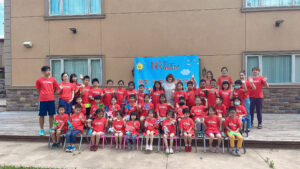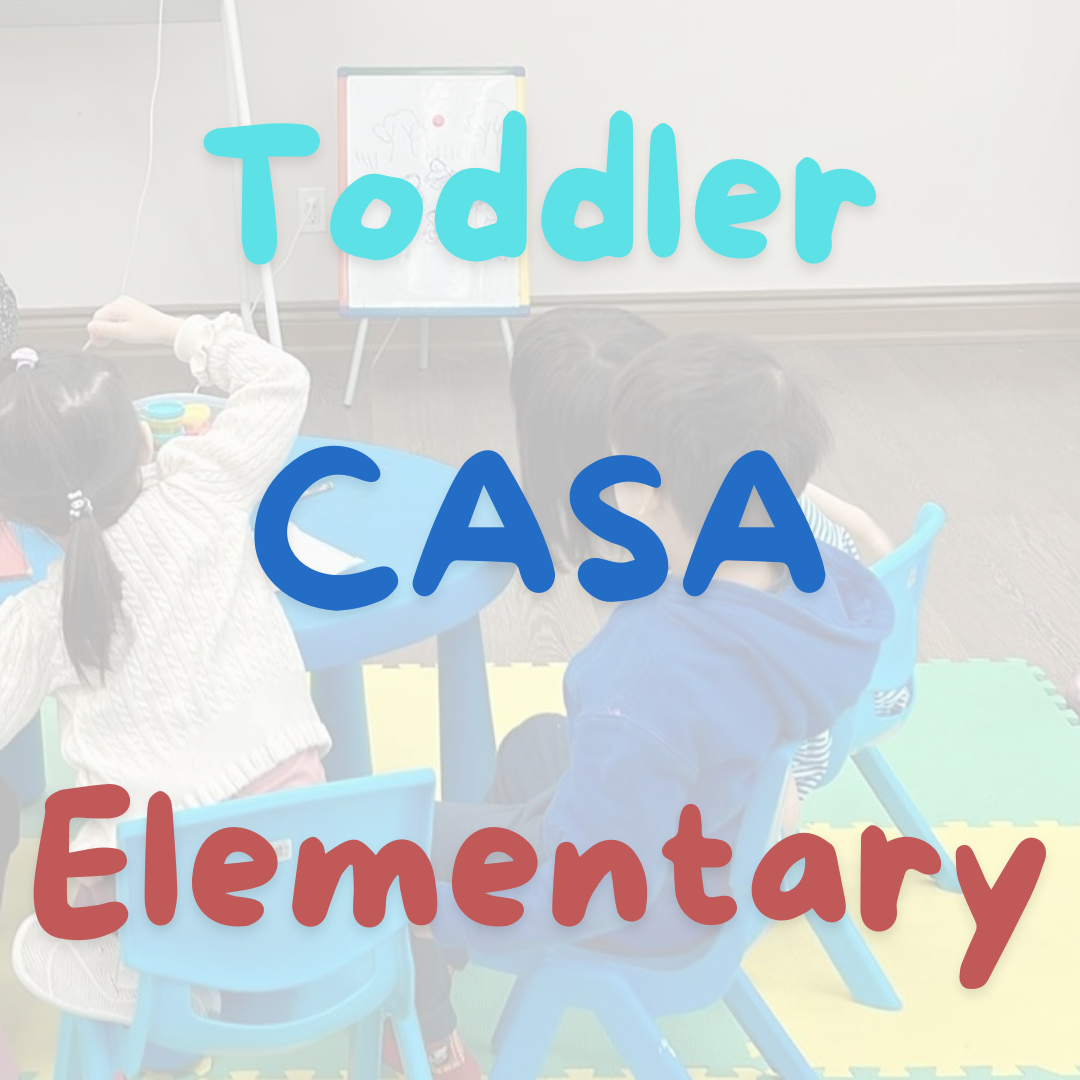Understanding developmental stages of children’s brains across three crucial phases: Toddler-hood (18 months – 3 years), CASA Preschool (3 – 6 years), and Lower Elementary (6 – 9 years).
1. Toddler-hood (18 months – 3 years)
During this stage, the toddler’s brain undergoes rapid development, particularly in areas associated with language, motor skills, and social cognition.
Language Development: According to research by Patricia K. Kuhl et al. (2010), toddlers’ brains exhibit remarkable plasticity, especially in language acquisition. The study suggests that between 18 and 24 months, toddlers’ brains become highly attuned to language sounds, facilitating rapid vocabulary growth and comprehension.
Motor Skills: The National Institute of Child Health and Human Development (NICHD) states that during toddlerhood, children’s brains develop crucial connections between the motor cortex and other brain regions, allowing for the refinement of motor skills such as walking, running, and grasping objects.
Social and Emotional Development: Harvard’s Center on the Developing Child emphasizes the importance of caregiver interactions during toddlerhood, as they play a vital role in shaping the brain’s social and emotional circuits. Positive interactions contribute to the development of empathy, emotional regulation, and the ability to form secure attachments.
2. Casa Preschool (3 – 6 years)
In the Casa Preschool stage, children’s brains continue to undergo significant growth, particularly in areas related to executive function, symbolic thinking, and socioemotional development.
Executive Function: The American Academy of Pediatrics (AAP) highlights that during the preschool years, the prefrontal cortex undergoes substantial development, leading to improvements in executive functions such as attention, working memory, and impulse control. These cognitive skills are essential for academic success and self-regulation.
Symbolic Thinking: According to Jean Piaget’s theory of cognitive development, children in the preschool years transition from the sensorimotor stage to the preoperational stage. This shift is marked by the development of symbolic thinking, where children begin to use symbols (e.g., words, drawings) to represent objects and ideas, reflecting advancements in their cognitive abilities.
Socioemotional Development: The National Association for the Education of Young Children (NAEYC) emphasizes the importance of social interactions and play in fostering children’s socioemotional development during the preschool years. Positive peer relationships and opportunities for cooperative play contribute to the refinement of social skills, empathy, and emotional regulation.
3. Lower Elementary (6 – 9 years)
During the Lower Elementary stage, children’s brains continue to mature, with a focus on further developing cognitive skills, academic abilities, and social competencies.
Cognitive Development: According to the Society for Research in Child Development (SRCD), children in the lower elementary years experience significant advancements in cognitive abilities, including logical reasoning, problem-solving, and abstract thinking. The brain’s capacity for complex thought processes expands as neural connections strengthen through learning and experience.
Academic Skills: The National Council of Teachers of Mathematics (NCTM) emphasizes the importance of early mathematical development during the lower elementary years. Children’s brains become increasingly adept at understanding mathematical concepts, such as number sense, arithmetic operations, and spatial reasoning, laying the foundation for future academic success in mathematics.
Social Competencies: The Collaborative for Academic, Social, and Emotional Learning (CASEL) highlights the role of schools in promoting children’s social and emotional competence during the lower elementary years. Through classroom activities and social interactions, children develop skills such as cooperation, conflict resolution, and empathy, fostering positive relationships with peers and adults.
In summary, children’s brain development progresses through distinct stages during toddlerhood, CASA Preschool, and Lower Elementary years, with each stage characterized by significant advancements in cognitive, linguistic, motor, and socioemotional domains. These developmental milestones lay the groundwork for future learning and academic achievement.
How should teaching methods change as a child go from Toddler to CASA?
This is a very common question! As children transition from toddlerhood to the CASA preschool stage, there are several adjustments teachers can make to their methods to accommodate the changing developmental needs and abilities of the children:
Transition from Toddler to CASA Preschool:
- Increased Structure and Routine:
- Toddlers thrive on routine, but as children enter the Casa stage, they are ready for more structured activities and schedules. Teachers can introduce predictable routines for activities like circle time, storytime, and free play, helping children feel secure and engaged.
- Focus on Language Development:
- While language development is crucial in both stages, Casa preschoolers are more capable of engaging in conversations and understanding complex instructions. Teachers can incorporate more language-rich activities such as storytelling, group discussions, and vocabulary-building games to foster communication skills.
- Introduction of Academic Concepts:
- Casa preschoolers are beginning to develop cognitive skills like symbolic thinking, which lays the foundation for academic learning. Teachers can introduce age-appropriate concepts in literacy, numeracy, and science through hands-on activities, games, and exploration, sparking curiosity and interest in learning.
- Encouragement of Independence:
- Toddlers are just beginning to assert their independence, but Casa preschoolers are ready to take on more responsibilities and make choices. Teachers can provide opportunities for children to practice self-help skills like dressing themselves, pouring drinks, and cleaning up, fostering autonomy and self-confidence.
- Promotion of Social Skills:
- While toddlers engage in parallel play, Casa preschoolers are ready for more cooperative interactions. Teachers can facilitate group activities, teamwork exercises, and problem-solving tasks to promote social skills such as sharing, taking turns, and resolving conflicts peacefully.
- Differentiated Instruction:
- Casa preschoolers have varying abilities and interests, so teachers should employ differentiated instruction techniques to meet individual needs. This may include small group activities, learning centers, and one-on-one support to ensure all children are challenged and supported appropriately.
- Emphasis on Creativity and Imagination:
- Casa preschoolers have vivid imaginations and are eager to explore creative expression through art, music, and dramatic play. Teachers can provide plenty of opportunities for open-ended activities, imaginative play, and artistic expression, allowing children to express themselves freely and develop their creativity.
- Positive Reinforcement and Encouragement:
- Both toddlers and Casa preschoolers benefit from positive reinforcement and encouragement, but Casa children can understand and respond to verbal praise and feedback more effectively. Teachers should acknowledge and celebrate children’s efforts and achievements, fostering a positive learning environment and boosting self-esteem.
By adjusting their teaching methods to align with the developmental needs and abilities of Casa preschoolers, teachers can create a supportive and enriching learning environment where children can thrive academically, socially, and emotionally.
How should teaching methods change from CASA to Early Elementary?
Well they’re certainly growing up right in front of your eyes aren’t they? Here is how we would approach this.
Transition from CASA Preschool to Early Elementary:
- Increased Academic Rigor:
- Early elementary students are ready for more structured and formal learning experiences. Teachers should incorporate age-appropriate curriculum standards and academic expectations into their lessons, focusing on foundational skills in literacy, numeracy, and other core subjects.
- Differentiation and Individualized Instruction:
- Early elementary classrooms often include a diverse range of learners with varying abilities and learning styles. Teachers should implement differentiated instruction techniques to meet the needs of all students, including small group activities, peer tutoring, and personalized learning plans.
- Development of Critical Thinking Skills:
- Early elementary students are capable of higher-level thinking skills such as problem-solving, analysis, and evaluation. Teachers should design activities and projects that encourage critical thinking, inquiry, and exploration, fostering intellectual curiosity and independence.
- Introduction of Formal Assessment:
- While assessment in Casa preschool may have been informal and observation-based, early elementary students may encounter formal assessments such as quizzes, tests, and standardized exams. Teachers should prepare students for these assessments by teaching study skills, test-taking strategies, and providing feedback on academic performance.
- Promotion of Independence and Responsibility:
- Early elementary students are developing a sense of autonomy and responsibility for their learning. Teachers should provide opportunities for students to take ownership of their work, set goals, manage their time, and make choices about their learning activities.
- Integration of Technology:
- Technology plays an increasingly important role in education, and early elementary students should begin to develop digital literacy skills. Teachers can incorporate educational technology tools and resources into their lessons to enhance learning experiences and prepare students for future academic and professional endeavors.
- Collaborative Learning Opportunities:
- Early elementary students benefit from opportunities to collaborate with their peers on projects, discussions, and group activities. Teachers should facilitate cooperative learning experiences that promote teamwork, communication, and interpersonal skills.
- Emphasis on Social-Emotional Learning:
- Early elementary students continue to develop social-emotional skills such as empathy, self-awareness, and relationship-building. Teachers should integrate such activities and strategies into the curriculum to support students’ emotional well-being and social development.
- Parental Involvement and Communication:
- As students transition to early elementary, teachers should maintain open communication with parents and caregivers, keeping them informed about their child’s progress, academic goals, and any concerns. Collaborating with families can enhance students’ educational experiences and promote continuity between home and school.
By adapting teaching methods to align with the developmental needs and academic expectations of early elementary students, teachers can create a supportive and engaging learning environment that fosters academic achievement, social growth, and lifelong learning skills.
Is It Hard to Teacher Different Age Groups at Once?
Personally I enjoy focusing on CASA but that’s just my preference. Teaching multiple age groups is like juggling a bunch of colorful balls at once – it’s challenging but also kinda thrilling! I’ve got to be like a superhero, catering to the diverse needs and abilities of each group while keeping the energy high and the learning fun. From adapting the curriculum to managing classroom dynamics and assessing progress, it’s a real balancing act. But hey, seeing those light bulbs go off in kids’ heads across different age ranges makes it all worth it. Sure, it’s a bit of a whirlwind, but I wouldn’t trade the excitement and variety for anything.
Anyway, hope you found my experience useful, and if not, I hope at least Google did.
Have a lovely day!





